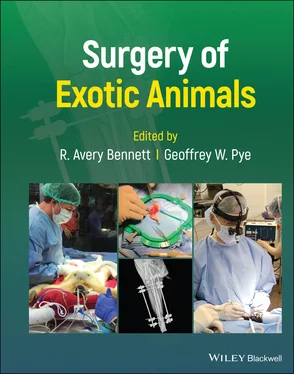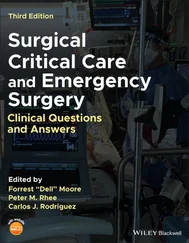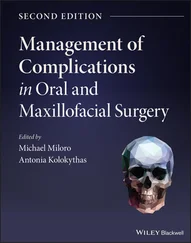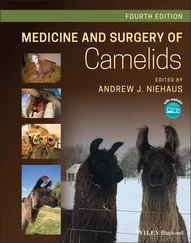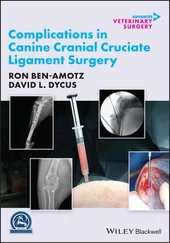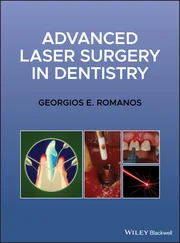Surgery of Exotic Animals
Здесь есть возможность читать онлайн «Surgery of Exotic Animals» — ознакомительный отрывок электронной книги совершенно бесплатно, а после прочтения отрывка купить полную версию. В некоторых случаях можно слушать аудио, скачать через торрент в формате fb2 и присутствует краткое содержание. Жанр: unrecognised, на английском языке. Описание произведения, (предисловие) а так же отзывы посетителей доступны на портале библиотеки ЛибКат.
- Название:Surgery of Exotic Animals
- Автор:
- Жанр:
- Год:неизвестен
- ISBN:нет данных
- Рейтинг книги:5 / 5. Голосов: 1
-
Избранное:Добавить в избранное
- Отзывы:
-
Ваша оценка:
- 100
- 1
- 2
- 3
- 4
- 5
Surgery of Exotic Animals: краткое содержание, описание и аннотация
Предлагаем к чтению аннотацию, описание, краткое содержание или предисловие (зависит от того, что написал сам автор книги «Surgery of Exotic Animals»). Если вы не нашли необходимую информацию о книге — напишите в комментариях, мы постараемся отыскать её.
The first book to provide veterinarians with in-depth guidance on exotic animal surgical principles and techniques Surgery of Exotic Animals
Surgery of Exotic Animals
Surgery of Exotic Animals — читать онлайн ознакомительный отрывок
Ниже представлен текст книги, разбитый по страницам. Система сохранения места последней прочитанной страницы, позволяет с удобством читать онлайн бесплатно книгу «Surgery of Exotic Animals», без необходимости каждый раз заново искать на чём Вы остановились. Поставьте закладку, и сможете в любой момент перейти на страницу, на которой закончили чтение.
Интервал:
Закладка:

Dr. Geoffrey W. Pyeserves Disney's Animals, Science, and Environment team as the Animal Health Director and joined the team in 2014 to lead the animal health and animal nutrition teams at Disney's Animal Kingdom, the Seas with Nemo and Friends at Epcot, the TriCircle D Ranch, Castaway Cay, and the Aulani Resort. He has also served a senior veterinarian for the San Diego Zoo, Werribee Open Range Zoo, and Currumbin Sanctuary. Geoff completed his bachelor of veterinary science at the University of Melbourne (1988) and earned a master of science in wild animal health from the University of London in association with the London Zoo (1995). He completed an internship in zoological medicine at Kansas State University (1998) and a residency in zoological medicine at the University of Florida (2001). Geoff is a Diplomate of the American College of Zoological Medicine (2001).
1 General Principles, Instruments, and Equipment
R. Avery Bennett
Introduction
Many surgeries in exotic animal are analogous to those performed in other species. The size of some patients makes surgery more challenging. Appropriate preoperative work up, patient preparation, surgeon preparation, perioperative antibiotic therapy, thermal support, and hemostasis are essential for a successful outcome. Preemptive, multimodal analgesia has long been known to improve recovery from surgery and is especially important with wildlife and exotic prey species. Additionally, in recent years, patients’ anxiety has become an important consideration when these patients have to be hospitalized. Use medications evaluated for the species having surgery to develop a preemptive analgesic and antianxiety treatment plan. When prey species experience anxiety, stress, fear, and pain, they often die for no apparent reason. Alternatively, they may recover from the surgical event only to die a day or two later, likely from these stresses. In pet species, it appears that if they are accustomed to being handled by humans they are more likely to survive the perioperative period. If multiple procedures need to be accomplished, as a general rule, it is better to perform multiple short anesthetic events and surgeries than to try to do everything under one long anesthetic event. This is especially true when imaging is needed for surgical planning. It is best to anesthetize the patient for imaging, then recover it and evaluate the study. Once a diagnosis is made and a plan developed, anesthetize the patient the next day for the surgical procedure.
It is important that patients resume eating for nutritional support as soon as possible after surgery. Many small patients are not able to undergo long periods of anorexia because they do not have the energy stores to support themselves because in their natural environment they are constantly eating. The nutritional needs of the patient must be addressed and supplemented as needed either per os, using a feeding tube, or intravenously.
Presurgical Considerations
Prior to performing surgery, it is vital to evaluate the patient and address any abnormalities. In many situations, fasting is recommended; however, sometimes it is not necessary. Hemodynamic support is important for all but the shortest surgical procedures. Patient and surgeon aseptic techniques should be followed for all surgeries regardless of size and species. Perioperative or therapeutic antibiotic therapy needs to be considered. Because small patients become hypothermic quickly, thermal support is essential even for diagnostic procedures done under anesthesia.
Patient Support
Small exotic animals are especially prone to developing perioperative complications such as hypovolemia from blood loss, hypothermia, and renal and respiratory compromise. It is important to evaluate the patient systemically prior to anesthesia and surgery and to address any abnormalities preoperatively. During anesthesia and surgery, provide fluid therapy to support the cardiovascular system. Monitor body temperature and take measures to minimize hypothermia. Take appropriate steps to minimize blood loss and take precautions to minimize the risk of surgical site infections.
Data Base
The ideal preoperative data base includes a complete blood count, serum or plasma biochemistry panel, and a urinalysis. Additional diagnostics may be indicated based on the species and the medical problem being addressed. For example, mice and rats are prone to mycoplasmosis pneumonia, and preoperative chest radiographs are indicated prior to anesthesia in these species. While it may be difficult to obtain a urine sample from a small rodent, they are prone to developing renal insufficiency later in life, so it is important to evaluate urine specific gravity and a dipstick for proteinuria. These can be done with two drops of urine that can be obtained by placing the patient in a plastic or glass container for several minutes. In ferrets, it is important to determine the blood glucose level prior to anesthesia because they are prone to forming insulinomas. In very small patients, it may not be feasible to take enough blood for all of the abovementioned diagnostics. At a minimum determine a hematocrit, total protein, blood urea nitrogen (azotemia test strip), glucose, and urine specific gravity.
Preoperative Fasting
Various species such as equids, rabbits, and rodents are not able to vomit for physiologic reason, so fasting to prevent aspiration pneumonia is not necessary. Additionally, if attempting to decrease gastrointestinal contents for a surgery, it can take days to make a difference because the majority of ingesta is within the hindgut. A short fast is recommended to allow these species to swallow any food material to reduce the risk of food entering the trachea during intubation. A prolonged fast in small mammals can result in a negative energy balance which increases their risk for developing complications after surgery (Jenkins 2000). Many small patients have low hepatic glycogen stores and may develop hypoglycemia during a prolonged fast (Harkness 1993; Redrobe 2002). Administer fluids containing dextrose subcutaneously (SC), intravenously (IV), or intraosseously (IOs) in patients prone to developing hypoglycemia. The gastrointestinal transit time in ferrets is rapid, and a prolonged fast is not recommended. An hour fast in ferrets is long enough for the stomach to empty minimizing the risk of developing aspiration pneumonia. On the other end of the spectrum, some reptiles may only eat once a week or even less often so there is no need for a fast.
Hemodynamic Support
Small patients have a small total blood volume and what may appear to be minimal hemorrhage can be life‐threatening. If the patient is anemic and surgery can be postponed, it should be postponed until the hematocrit is into the normal range. It would be a rare event that surgery made a hematocrit increase, typically the opposite is the norm. Consider a blood transfusion from a conspecific, if more than minimal hemorrhage is anticipated or if the patient is anemic preoperatively. Strict attention to intraoperative hemostasis is essential when performing surgery on any small patient.
In patients experiencing serious blood loss during surgery, crystalloid or colloid fluid therapy should be administered as quickly as possible for cardiovascular support. More ideal, blood from a conspecific should be used, but often this is not available. Preplanning by having a conspecific blood donor available can be life‐saving. In ferrets, there are no blood types and no reports of transfusion reactions. It is safe to use any ferret as a blood donor. In many species, blood typing may not be known. If it is unknown whether a species has blood types, a crossmatch should be performed prior to administering a blood transfusion.
Читать дальшеИнтервал:
Закладка:
Похожие книги на «Surgery of Exotic Animals»
Представляем Вашему вниманию похожие книги на «Surgery of Exotic Animals» списком для выбора. Мы отобрали схожую по названию и смыслу литературу в надежде предоставить читателям больше вариантов отыскать новые, интересные, ещё непрочитанные произведения.
Обсуждение, отзывы о книге «Surgery of Exotic Animals» и просто собственные мнения читателей. Оставьте ваши комментарии, напишите, что Вы думаете о произведении, его смысле или главных героях. Укажите что конкретно понравилось, а что нет, и почему Вы так считаете.
